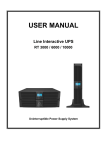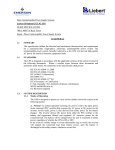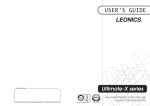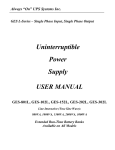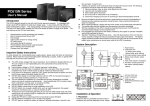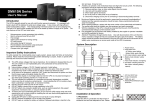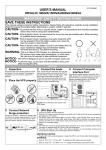Download USER MANUAL
Transcript
USER’S MANUAL 192321362004000 1000VA/1500VA/2000VA/3000VA IMPORTANT SAFETY INSTRUCTIONS SAVE THESE INSTRUCTIONS This manual contains important safety instructions. Please follow all instructions carefully during installation. Read this manual thoroughly before attempting to unpack, install or operate. CAUTION- To prevent the risk of fire or electric shock, install in a temperature and humidity controlled indoor area, free of conductive contaminants. CAUTION- Risk of electric shock, do not remove the cover. No user serviceable parts. Refer servicing to qualified service personnel. CAUTION- Risk of electric shock, hazardous live parts inside this UPS can be energized from the battery supply even when the input AC power is disconnected. WARNING- This is a Class A-UPS Product. In a domestic environment, this product may cause radio interference, in which case, the user may be required to take additional measures. NOTICE- The UPS is designed to be for use with computer loads only. NOTICE- To prevent injury, do not carry with the handle of front cover when moving the UPS. 1 Inspection Inspect the UPS upon receipt. Notify the carrier and dealer if there is damage. The package is recyclable; save it for reuse or dispose of it properly. 2 Place the UPS properly SETUP 3 Connect the loads First, connect the UPS with Utility, then plug the loads onto the outlets on the rear of the UPS. To use the UPS as a master “On/Off” switch, make sure that all of the loads are switched “On”. These UPS outlets provide battery power and surge protection to the equipment when Utility voltage is outside acceptable limits. 4 Connect Computer Interface Port Connect the supplied interface cable (RS-232 or USB) between the interface port on the rear of the UPS and the computer interface port. See software installation guide in the CD-ROM for installation purpose. Caution: Do not connect a laser printer to the UPS outlets. 5 Connect Network Surge protection 6 UPS Start Up 1. Connect the UPS to the wall receptacle. LCD will display “OFF”, when Utility is normal. If there is nothing on the LCD, go to step 3. Connect a 10 base-T / 100 base-T network cable 2. Push the “On” Switch on the front panel to start the UPS. Both the LCD and Utility LED (Green) with the RJ-45 network surge protection “IN” jack are lit. The start-up procedure is completed and the loads are supplied by the UPS. on the rear of the UPS. Connect from the “OUT” 3. To cold start the UPS, press the “On” Switch on the front panel for approximately 3 seconds until jack with network cabling to network equipment. the LCD lights up and buzzer sounds, then release the “On” Switch. The UPS starts operating and Battery Backup LED (Amber) lights up. The cold start-up procedure is completed and the loads are supplied by the UPS. 4. The UPS will run under Backup mode and the buzzer alarms every 2 seconds in case of blackout or over/under voltage. On the contrary, If Utility is back to normal and then the UPS will run under Utility mode and silence alarm. Caution: The UPS will remain at “NO” output, if the start-up operation is not proceeded properly even though the Input Power Cord is connected to the wall receptacle. IN OUT IMPORTANT NOTICE: Plug the UPS onto the wall receptacle to charge the UPS for over 8 hours after initial installation. STORAGE: Store at -15 to +30 °C (+5 to +86 °F), charge the UPS battery every six months. Store at +30 to +45 °C (+86 to +113 °F), charge the UPS battery every three months. Operation Test Turn Off the UPS Press the “Off” Switch for at least 3 seconds to turn off the UPS. If you press the “Off” Switch less than 3 seconds, the UPS will not execute shutdown command due to insufficient pressing time. In some occasions, the UPS will shut itself down in case of overload, output short-circuited or battery cutoff point reached in the Backup mode. The UPS will automatically shut off the output and beep for 5 seconds then completely shut itself down. Plug-in Charge If the Input Power Cord is connected to the wall receptacle properly and the utility is normal, the UPS will start charging automatically without processing “Turn On” procedure. You have to charge for at least 8 hours every 3 months to avoid from battery self over-discharge naturally, if the UPS is in an idle condition. Auto-Restart If the Input Power Cord is connected to the wall receptacle properly and Utility is back to normal, the UPS will automatically restart to provide energy to the output after battery cut. Alarm Silence The Alarm might be turned off by pressing the “On” Switch for approximately 1 second in the “Backup” mode. Unless any other warning or fault condition occurs, the alarm remains at Silence condition once the “Alarm Silence” is turned off. Test Under Utility Normal condition, press the “On” Switch for 3 seconds to execute the Battery Self-test function. In case the battery is normal, it will enter into the Battery Backup Mode for 10 seconds then return to Utility Mode. If the battery voltage is detected lower than set limit, the Battery Replacement mark will blink for 5 times then extinguish to stop self-test procedure. And if battery is detected weak or dead, the Battery Replacement mark will steadily illuminate. FRONT PANEL EXPLANATIONS 1. Utility ( Green LED) 2. Fault (Red LED) 3. On Switch 4. Off Switch 5. Battery Replacement 6. Battery Backup (Amber LED) 7. Battery Low 8. Bypass 9. Utility Low, UPS Boost 10. Utility High, UPS Buck 11. UPS Output Indicator 12. Polarity Error or Ground Fault 13. Over load 14. Load/Battery Level (%) 15. Load/Battery Level Indication Control Button REAR PANEL EXPLANATIONS 1. 2. 3. 4. 5. 6. RJ45 Port DIP Switch USB Communication Port RS232 Communication Port Output Breaker Outlet 7. 8. 9. 10. 11. Rating Label Input Breaker Input Power Socket(Inlet) SNMP Slot External Battery Terminal REPLACING THE BATTERY Note: Once the battery is disconnected, the loads are not protected from power outages. When the Battery Replacement mark lights up, you may leave the UPS to be re-charged for at least 8~10 hours to see whether the mark will be extinguished after the Self-test Function is executed again. In case the mark remains unchanged, you may unscrew the Hot Swappable Battery cover to replace a new battery pack, and then press the “On” Switch to disable the mark. Please follow the steps 1-3 to draw out the old batteries. Then slide in the new batteries into the UPS. Close the front panel and fasten two screws. Dispose of the old batteries properly at an appropriate recycling facility. STEP 1 STEP 3 STEP 2 DIP SWITCH SETTING The nominal voltage of the UPS might be re-set by the DIP Switch on the rear panel of the UPS. The following charts may bring you clear pictures about how the settings are done by the DIP Switch. FUNCTION 2 1 VOLTAGE=110V ↑ ↓ VOLTAGE=115V ↓ ↓ VOLTAGE=120V ↓ ↑ FUNCTION 2 1 VOLTAGE=220V ↑ ↓ VOLTAGE=230V ↓ ↓ VOLTAGE=240V ↓ ↑ INDICATORS & ALARMS Indicator Color Description Alarm Utility Mode Green None Backup Mode Amber Fault Red Steady: Output Load is supplied by Utility. Blinking: Polarity error or Ground Fault Steady (with alarm): Output Load is supplied by Battery Blinking every 5 seconds (no alarm):Stand by for Utility recovery to re-start up When Overload, short circuit, or Output Voltage Abnormal occurs Blinking: Battery is weak and needs to be recharged. Steady: Battery is dead. Battery N.A. Replacement Every 2 seconds before battery Low and every 1 second before battery Cutoff. Buzzer beeps continuously. None




